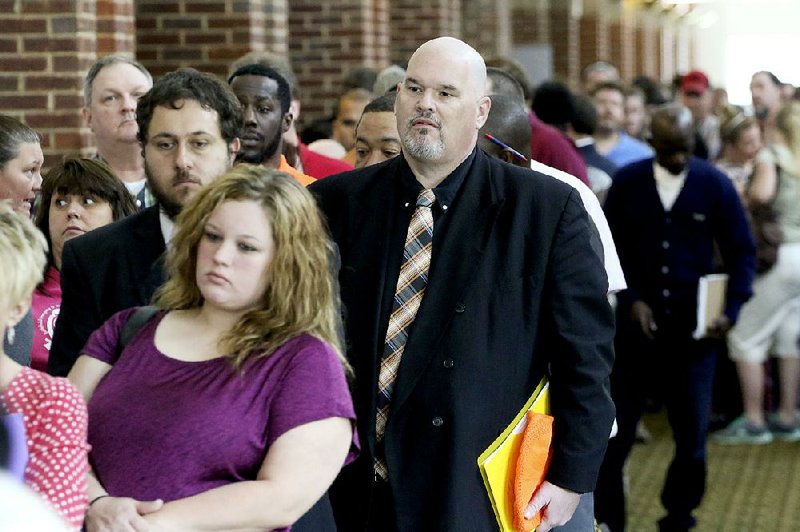WASHINGTON -- U.S. companies hired in April at the slowest pace in nearly a year and a half, a private survey found, as the strong dollar dragged down overseas sales and energy companies cut back on spending in the face of lower oil prices.
Payroll processor ADP said Wednesday that businesses added just 169,000 jobs in April, down from 175,000 in the previous month. That was the fewest since January 2014. March's total was revised down from 189,000.
"It's disappointing, but I don't think it's necessarily a disaster," said Scott Brown, chief economist at Raymond James Financial Inc. in St. Petersburg, Fla. A gain of "169,000 is still pretty good. In a normal situation, that would be great, but we still have a lot of slack that we need to take up from the recession."
The weak showing could raise fears that the economy is slipping into a period of sluggish growth, after expanding at a healthy pace for most of last year. A big increase in the trade gap, reported Tuesday, means the economy probably shrank in the first quarter.
That could weigh on job gains. Employers added just 126,000 jobs in March, according to the government's data, the fewest in 15 months. April's jobs report will be released Friday, and economists forecast hiring rebounded to 220,000 last month. But the disappointing ADP figures suggest that hiring could remain sluggish.
Many economists discounted the report, however, because the ADP survey has a spotty track record of forecasting the official figures. It covers only private businesses and sometimes diverges from the government's comprehensive report. Analysts note that other job market data, such as the low level of applications for unemployment benefits, indicate that Friday's job gains should be healthy.
"The ADP is no fortuneteller," Bricklin Dwyer, an economist at BNP Paribas, said in a note to clients.
Hiring in April fell sharply among companies with more than 500 workers, according to ADP. They added just 5,000 jobs, the fewest in six months.
Mark Zandi, chief economist at Moody's Analytics, blamed the shortfall mostly on the dollar's strength, which makes large companies' exports more expensive overseas. The dollar has risen about 15 percent in value against a variety of other currencies in the past year. Moody's helps compile the ADP data.
The strong dollar has also hit factories, which shed 10,000 jobs last month, the most in more than five years, according to ADP. Falling oil prices also have slowed manufacturing, as energy companies cut orders for steel pipe and other machinery needed for drilling.
U.S. worker productivity declined in the first three months of the year as labor costs jumped, reflecting a slowdown in growth.
The Labor Department said Wednesday that productivity, which is the amount of output per hour of work, fell at a 1.9 percent rate in the first quarter. Productivity dropped at a 2.1 percent rate in the final three months of 2014.
Labor costs surged 5 percent in the first quarter, after having increased 4.2 percent in the fourth quarter.
Falling productivity coupled with higher labor costs are usually a negative for the economy. Increased worker productivity generally fuels stronger economic performance.
But the figures can be volatile on a quarterly basis. This is only the third back-to-back quarterly decrease in the past 25 years.
Overall economic growth essentially flat-lined in the first quarter, rising at a tepid annual pace of only 0.2 percent, the government reported last week. The combination of harsh winter weather, falling oil prices hurting domestic energy firms and a West Coast ports dispute appears to have stifled the economy at the start of the year. Gross domestic product had risen at an annual rate of 2.2 percent in last year's October-December quarter.
The seemingly temporary factors at the start of the year have led many economists to expect productivity to recover somewhat.
"This is exactly what happened at this time last year, when the unseasonably bad winter hit output more than employment," said Paul Ashworth, chief U.S. economist at Capital Economics. "Productivity will rebound in the second quarter and unit labor costs will drop back."
Information for this article was contributed by Christopher S. Rugaber and Josh Boak of The Associated Press and by Victoria Stilwell of Bloomberg News.
Business on 05/07/2015
